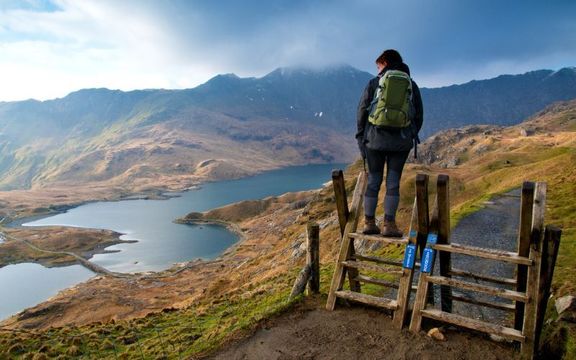
Pyg track ascending Snowdon, Wales Getty
Long before man set foot in Britain, nature was busy leaving its mark creating some of the world’s famous natural attractions.
The Giant’s Causeway
Located in Northern Ireland, The Giant’s Causeway was formed either through volcanic activity or as a result of an argument between Finn McCool, a local giant and his enemy who lived across the water in Scotland. Legend has it that a Scottish giant called Benandonner laid claim to Ireland, and when McCool heard this he became so enraged he started to rip up chunks of the Antrim coastline and throw them haphazardly into the sea. This haphazard approach resulted in the Causeway you see now when McCool decided to use the boulders as a way to reach Scotland and challenge Benandonner once and for all.
The 40,000 basalt columns which form the Causeway are just one of the area’s attractions. The Giant’s Causeway is located on the Causeway Coastal Route which also takes in the Carrick-a-Rede Rope Bridge. Canny tourists time their visit alongside a tour of the nearby Bushmills Distillery and enjoy a dram or two of whiskey!
Snowdonia National Park
Snowdonia, or Eryri, is the largest national park in Wales and is home to mountain ranges, miles of coastline and native woodland over its total 823 square miles. Perhaps most interestingly, Eryri is also home to 26,000 people - almost half of whom speak Welsh - who have infused the area with a rich cultural and historical heritage. The language is used daily and is experienced by the nearly 4 million people who visit the area each year.
Main attractions across the park include the uplands, which form nine mountain ranges formed as a result of volcanic activity, glacial movement and continental collision, and give walkers and hikers ample opportunity to explore and marvel at the stunning landscape. For those a little less active, we recommend visiting the local communities and enjoying food and drink with those who live there. With many of the placenames taking inspiration from Welsh myths and legends, asking a local is the only way to discover the truth!
Cheddar Gorge
One of Somerset’s biggest attractions, Cheddar Gorge boasts the stunning cliffs for which its famous and the subterranean stalactite caves which are among the most impressive in the world. It offers up secrets and information and our prehistoric ancestors and offers historians a unique insight. Alongside the cliffs comes the caves, including the famous Gough’s cave which is over 500,000 years old. The largest of the Gorge’s four caves, all of which are decorated with stalagmites and stalactites.
Best of all for those on a budget visiting the Gorge is completely free of charge! With access via public footpaths and a road from the nearby village of Cheddar, this free access makes it especially popular during the summer months. Fees do apply to attractions within the Gorge such as the Caves and Jacob’s Ladder and of course for those who want to take advantage of the rock climbing opportunities.
Pistyll Rhaeadr
One of the Seven Wonders of Wales, Pistyll Rhaeadr is a stunning waterfall that attracts crowds during the warmer months due to its beauty and the plunge pools located at its base. The waterfall, which is the tallest in both England and Wales, is formed by the falling in three stages of the Afon Disgynfa over a 240-foot cliff face in the Afon Rhaedar below. The name itself means Spring of the Waterfall and Pistyll Rhaeadr is one of the few Welsh waterfalls you can actually walk behind.
It’s located a few miles from Llanrhaeadr-ym-Mochnant - twelve miles west of Oswestry - in North East Wales. The waterfall is surrounded by the Berwyn mountains and undisturbed land which has become a haven for wildlife. The walk to the top of the waterfall from its carpark takes approximately 20 minutes but many choose to rent bikes and explore the surrounding scenery and villages.
The Old Man of Storr
Whether you choose to believe that The Old Man of Storr was caused when a giant lay down upon death but left his thumb above earth or that it was caused by a landslide thousands of years ago, there’s no disputing its beauty. Located on Scotland’s Isle of Sky, it is actually a formation of rocks, with ‘storr’ referring to the collection of rocks that surrounds the old man’s thumb. Despite being at an elevation of more than 2,300 feet, the Old Man is accessible through a hiking trail of less than 4km making it a popular trail for tourists and locals alike due to the stunning views of the water and mainland visible when you reach the top.





Comments